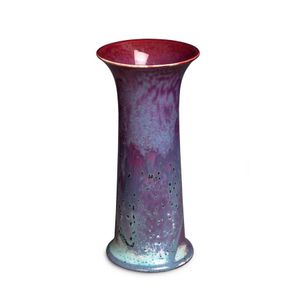Kangxi Prunus Vase with Ice Crackle Ground
You must be a subscriber, and be logged in to view price and dealer details.
Subscribe Now to view actual auction price for this item
When you subscribe, you have the option of setting the currency in which to display prices to $Au, $US, $NZ or Stg.
- Crackles / Cracquelure - In ceramics, crackles may be introduced intentionally during the firing process, as was often the case with Oriental ceramics, and are known as artificial crackles. Natural crackles occur with age, and if the glaze is transparent, may be difficult to detect. Natural crackles may not cover the whole surface of the object and may be uneven in size.
- Crackling and Crackle as a Decorative Technique - Crackle, also known as crackling, is a decorative technique that has been used in China for centuries. It is believed to have originated during the Song Dynasty (960?1279 AD) and was primarily used in the production of ceramics, lacquerware, and furniture. The crackling effect was achieved by applying a glaze or lacquer that was formulated to crack during firing, creating a crackled pattern on the surface of the item.
During the Ming Dynasty (1368?1644 AD), crackle became a highly sought-after decorative technique, and it was used to create intricate and beautiful designs on ceramics and lacquer ware.
In Western decorative arts, crackle / crackling came into use during the Art Nouveau movement in the late 19th and early 20th century. The crackling effect was used to create a sense of movement and fluidity in the design of Art Nouveau pieces.
It was also used in the 1920s and 1930s during the Art Deco movement. - A/f, as Inspected - The letters "A/F" or "as inspected" as part of a description is the cataloguer's shorthand for "all faults" or "as found", meaning the item has some type of damage or deficiency, it is of uncertain date or provenance, and/or that the seller takes no responsibility for the completeness of the item or the accuracy of the description.
This item has been included into following indexes:
- Chinese ceramics, dynasty mark or period
-
Chinese ceramics, item type
- gu shaped ceramic vases 63
- vases, other 2,540
Visually similar items

A pair of Chinese porcelain enamel Gu-shaped vases. Decorated in Guangxu style with cockerels among blossoms, a band of ruyi design to the neck, 37 cm high, (one with small repair to lip, the other with minor chips to rim)

Two blue and white beaker vases, Gu, Qing dynasty, Kangxi Period, (2), each painted with upright stiff leaves extending from the central bulb encircled with ribboned emblems and florettes, the base of one with, leaf mark, box, (2), 17.6 cm and 20 cm high

A Ruskin Pottery red-lavender flambe glazed vase, dated 1906, 24 cm high

A carved white-glazed yenyen vase, 20th century, the splayed base and tall trumpet neck decorated with a mountainous landscape above and below the central bulb encircled with two dragons and ruyi fungus, the base pierced with a central aperture, inscribed
